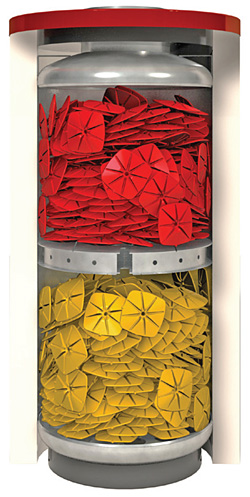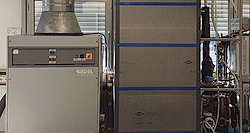 Heatsel® is lens-shaped, plate-sized and a real break-through in the area of heat and cold storage as it increases the storage capacity of heat and cold storages by up to three or four times. By macro-encapsulation of phase change materials (PCM) the German company ESDA developed with its subsidiary Axiotherm a high-performance, high-capacity but cost-efficient user-friendly solution that can be introduced into the storage subsequently as well. The European commission recognised the Heatsel®'s innovation and market potential and is supporting its implementation with the SME instrument. The project application of ESDA received the highest points out of the total 135 submitted applications in the "energy" category, making the first place among Europe's most innovative ideas.
Heatsel® is lens-shaped, plate-sized and a real break-through in the area of heat and cold storage as it increases the storage capacity of heat and cold storages by up to three or four times. By macro-encapsulation of phase change materials (PCM) the German company ESDA developed with its subsidiary Axiotherm a high-performance, high-capacity but cost-efficient user-friendly solution that can be introduced into the storage subsequently as well. The European commission recognised the Heatsel®'s innovation and market potential and is supporting its implementation with the SME instrument. The project application of ESDA received the highest points out of the total 135 submitted applications in the "energy" category, making the first place among Europe's most innovative ideas.
THE TECHNOLOGY
For decades, there have been attempts to transfer PCM such as paraffins or salt hydrates into a user-friendly form. Before now, it was assumed that micro and macro encapsulation of PCM would be unsuitable for a broad application, both technically and economically. But Heatsel® proves the precise opposite.
Latent storage systems can only achieve sensible integration into complex systems such as technical building equipment if not only their capacity, but also the discharge and charging power can be controlled in a wide range, and in a temperature range that is as precisely defined as possible. Therefore, the Heatsels® are surrounded by a heat carrier medium (e.g. water), to optimise heat transfer from the heat carrier to the PCM.
In the Futurium – the so called "house of the future" in the neighbourhood of the Federal Ministry of Education and Research in Berlin – such a PCM storage forms a central part of the innovative cooling concept. The production of cold with a delay and its demand will be bridged by five storages holding more than 9,000 litres and equipped with 9,500 Heatsels®. At the same time, the current output can be controlled by the variable mass flow on the primary and secondary sides: It is possible to temporarily take a higher output from the storage than was fed in on the primary side. The internal heat transfer processes are of the utmost importance for this.
The project is therefore supported from the beginning by the department of energy/building/environmental technology of the University of Applied Sciences in Münster under management of Professor Bernd Boiting, who built the corresponding test benches and developed empirical approaches in order to permit performance examinations of latent storages and development of calculation approaches. The Figure below shows the hydraulic module that can be used to charge and discharge any storage elements in a defined manner and to change framework conditions and flow directions, in order to develop a simple planning tool for system planners and constructors in the end.
THE ADVANTAGES OF PCM
 Thermal storages based on PCM are comparatively space-saving and permit efficient charging and discharging. Thermal energy can be saved and emitted on the temperature level at which the upstream energy converters work efficiently and connected systems are optimised. At the same time, they can relieve the mains when they reduce energy consumption in buildings and balance it out over time. Energy converter runtimes can be delayed or extended, which increases system efficiency and reduces the size of the energy converters. Thermal storages are therefore also of interest in connection with the "Smart Grid", in order to use the option of larger "virtual" storage units. Regeneratively generated power can be easily converted into heat via resistance heating – or more efficiently into heat or cold as required via compression chillers.
Thermal storages based on PCM are comparatively space-saving and permit efficient charging and discharging. Thermal energy can be saved and emitted on the temperature level at which the upstream energy converters work efficiently and connected systems are optimised. At the same time, they can relieve the mains when they reduce energy consumption in buildings and balance it out over time. Energy converter runtimes can be delayed or extended, which increases system efficiency and reduces the size of the energy converters. Thermal storages are therefore also of interest in connection with the "Smart Grid", in order to use the option of larger "virtual" storage units. Regeneratively generated power can be easily converted into heat via resistance heating – or more efficiently into heat or cold as required via compression chillers.
ACHIEVING MORE TOGETHER
The innovation consultancy EurA AG has essentially contributed to successfully applying for subsidies. The company has seven offices in Europe and, among others, manages the "Energy Innovation Europe" network, bundling other innovative companies in Europe in addition to ESDA in order to establish sustainable international cooperation for the development of new technologies in the entire energy area. The network is open to new members.
Phase Change Materials
Phase Change Materials – PCM www.pcm-ral.de – are materials that can reveribly change their state of aggregation based on exteernal, usual thermal, energy input/discharge. When they change from solid to liquid, they take up a great amount of thermal energy at a constast temperature. they will discharge this "latent" stored energy again on crystallisation at the same temperature level. This way, a lot of thermal energy can be stored in small spaces and at a consistent temperature.
PCM storages are therefore a more efficient technology than conventional water storages. At the same time, their small working temperature differences increase the efficiencies of thermal heating and cooling processes.
Information:
web: www.technologie.esda.de
web: www.axiotherm.de
web: www.energy-innovation-europe.eu
web: www.eura-ag.eu
This project has received funding from the European Union's Horizon 2020 research and innovation programme under grant agreement No 778788